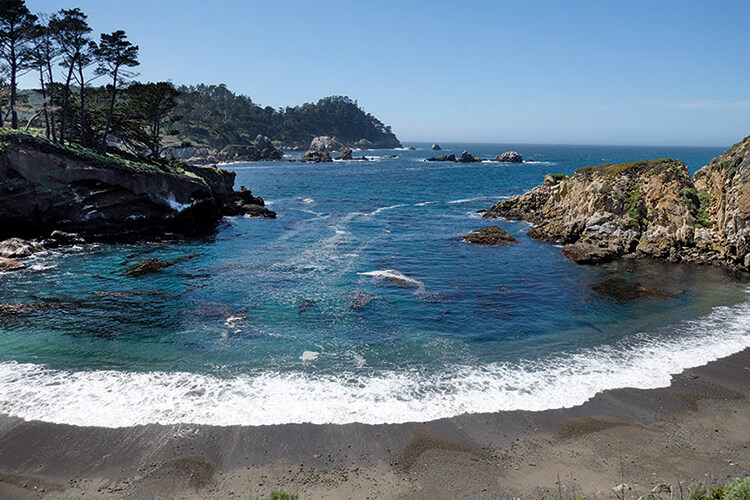 In 1981, during his first year as a volunteer docent at Carmel’s Point Lobos State Natural Reserve, Reid Woodward stationed himself near China Cove with a spotting scope. As visitors took their turns surveying the scene, Woodward noticed a sea otter swimming along a mossy stone. She circled the area for an unusually long time, and then eventually climbed atop the rock and gave birth.
In 1981, during his first year as a volunteer docent at Carmel’s Point Lobos State Natural Reserve, Reid Woodward stationed himself near China Cove with a spotting scope. As visitors took their turns surveying the scene, Woodward noticed a sea otter swimming along a mossy stone. She circled the area for an unusually long time, and then eventually climbed atop the rock and gave birth.
It was an electrifying moment for Woodward and his guests, especially given the endangered status of sea otters. And, as he later learned, it was a rare incident at Point Lobos.
“When I told a ranger what I had seen,” Woodward remembers, “he dropped everything and said, ‘I want you to sit down with this pen and paper and write out what you watched. No one here has ever seen a sea otter being born.'”
Today, Woodward is one of three individuals from that first Point Lobos docent class still volunteering at the reserve—and, he’s one of approximately 225 Point Lobos Foundation guides who regularly donates time to the organization. Founded in 1978 as the Point Lobos Natural History Association, the 40-year-old nonprofit supports interpretive programs, educational outreach and preservation projects at Point Lobos State Natural Reserve.
In its early years, the organization concentrated primarily on training docents and creating visitor materials in various languages. Since hiring its first full-time staff member in 2013, the Point Lobos Foundation has taken on a bigger role.
“We’ve become a more comprehensive partner for California State Parks. We’re building accessible trails, completing restoration projects and researching the natural resources inside Point Lobos, so that they can be best protected over the long term,” says Anna Patterson, the foundation’s executive director.
While the group has approximately 750 members, more than 2,500 individuals support its work each year through grants, gifts and other contributions. In addition to maintaining trails and training the docents who lead tours, educate school groups and staff the park information center and on-site museum, the foundation oversees a library of historical information and field research. Members also publish a magazine and hold fundraising events on behalf of the Point Lobos.
In December, volunteers transplanted 16,000 native plants during the first stage of a comprehensive restoration initiative at the reserve. The foundation rallied and organized volunteers for the ongoing project, and helped cover some related expenses.
“These types of projects fit right into our mission. We’ve been able to do them in the past, but with current staff shortages and capacity limitations, we’re not always able to make things happen,” says Brent Marshall, Monterey sector superintendent for California State Parks. “The Point Lobos Foundation provides thousands of hours of assistance, all within the sensitive rules and regulations of the state. It’s the perfect partnership.”
In 2017, the Point Lobos Foundation hired a restoration ecologist who is helping to outline future trail and coastline campaigns in the reserve. Patterson’s recent promotion from development and communications director to executive director further solidifies the organization’s commitment to the destination.
“We want to increase our impact and make sure that Point Lobos remains the crown jewel in the state park system, as people often say it is. As we provide financial and interpretive support, we also want to ensure that this reserve still offers an incredible experience for the hundreds of thousands of people who visit each year,” says Board President and Monterey Bay Aquarium Chief Operating Officer Cynthia Vernon.
She lists docent development and expanded school programming, including a focus on introducing underserved students to Point Lobos, among the projects that make her most proud. In an effort to reach new audiences, the foundation has created a Discover Point Lobos mobile app with games, photographs, information and interactive features. The group also supported the planning and construction of trails that better accommodate wheelchairs, strollers and individuals with limited mobility, and leaders are working with local partners to manage vehicle access and parking issues related to record visitor numbers.
Between 750,000 and one million guests explore Point Lobos annually.
“It’s really become a must-see, must-do experience for tourists,” Vernon says. “It’s a beautiful, historic piece of public land that lets those of us who live here recharge and reconnect with the ocean and the coastline.”
“There’s no other place like it, really,” agrees Point Lobos Foundation volunteer Reid Woodward.
“Up and down the California coast, the Sierras and Yosemite, they’re all wonderful in their own way. But this place is truly spectacular. It’s well preserved, and it’s small enough that you don’t have to walk 20 miles to see all the features. There’s not another place I’d rather be, and I think most of us who work out there feel that way.”
To volunteer with the Point Lobos Foundation, or to make a donation or become a member, please visit www.pointlobos.org.